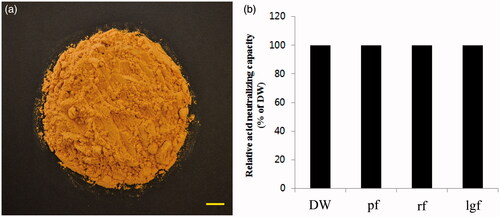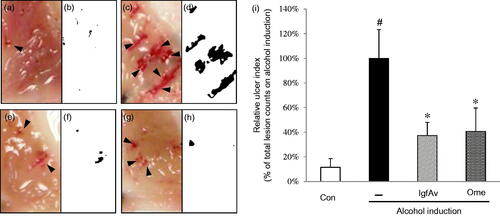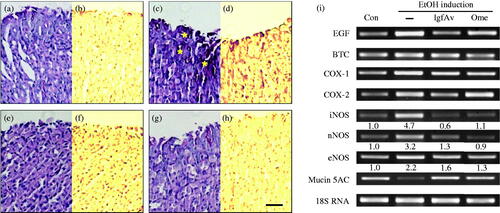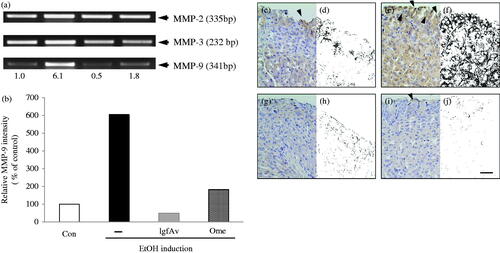Figures & data
Figure 1. Classical feature of Aloe vera gel fraction and measurement of acid neutralizing potential. Scale bar, 1 cm. DW: distilled water; pf: polymer fraction; rf: retentate fraction; lgf: low molecular-weight gel fraction. Details of preparation method of fractions are included in Materials and Methods section (a). Relative acid neutralizing capacity was determined (b).

Figure 2. Gastroprotective effects of Aloe vera gel fraction on mucosal tissues in alcohol-induced acute gastric lesion model. Mice were randomly divided into (a and b) control, (c and d) alcohol alone (8 mL/kg), (e and f) gel (150 mg/kg) and (g and h) omeprazole (3 mg/kg) with alcohol treatment (8 mL/kg; n = 7). After oral (p.o.) administration, mice were returned to their cages for 30 min to apply drug metabolism. Mice were not allowed food or water during alcohol induction. Mice were euthanized, and the tissues were anatomically examined for visible signs such as scars or clumps of blood caused by ulcer, or both. (i) Gastric lesion index was measured and expressed relative to intensity of control. Gastric lesions were counted as described in Materials and methods section. Data are mean ± standard deviation (SD, n = 7 animals/group). #p < 0.05 and *p < 0.05 compared with control and alcohol-administered group, respectively. Results were analysed using multiple range Dunnett′s test. Con: control; –: alcohol induction alone; lgfAv: low molecular-weight fraction of Aloe vera; Ome: omeprazole. Each image (a–h) is divided into two parts: clinical observation and image analysis (see Materials and Methods for details).

Figure 3. Immunohistochemical and reverse transcription-polymerase chain reaction (RT-PCR) analyses confirming inhibition by Aloe vera gel fraction. After deparaffinization, tissue sections were rehydrized and oxidized in 1% (v/v) periodic acid for 5 min. Then, sections were washed with distilled water (DW) and stained with Schiff′s reagent for 15 min. Thereafter, sections were counter-stained with Mayer′s haematoxylin and rinsed in running tap water. They were finally dehydrated, cleared and mounted. Sections of (a and b) control, (c and d), only alcohol-treated, (e and f) alcohol-treated with gel fraction and (g and h) omeprazole-treated groups were observed using phase contrast microscope (Axovert 200, Carl Zeiss, Weimar, Germany); (i) *Acute gastric lesions. Comparison of mRNA expressions of alcohol-induced acute lesions using RT-PCR. PCR conditions are described in Materials and Methods section. Data show representative classical analysis in triplicate independently.

Figure 4. Matrix metalloproteinase (MMP)-9 protein expression is associated with gastroprotection by Aloe vera gel fraction against alcohol-induced acute gastric mucosal lesions. (a) mRNA expressions of MMP-2, -3 and -9 using reverse transcription-polymerase chain reaction (RT-PCR). Each tissue sample was homogenized, quantified and subjected to RT-PCR as described in the Materials and Methods section. (b) Relative band intensity is shown. (c, d) Sections of control, (e, f) only alcohol-treated, (g, h) alcohol-treated with lgfAv and (i, j) omeprazole-treated groups were immunohistochemically stained with MMP-9 antibody and visualized using secondary antibody. Dark blots (arrowheads) indicate MMP-9-responsive cells, which are secreted or bound with MMP-9 cells.

